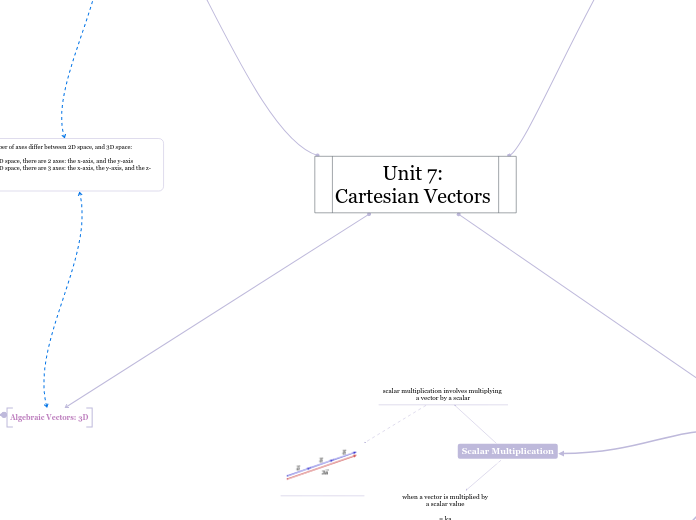por Cindy Nguyen hace 2 años
255
Unit 7: Cartesian Vectors

por Cindy Nguyen hace 2 años
255

Ver más
Distributive Property: u×(v + w) = u × v + u × w
Associative Property: k(u×v) = (ku)×v = u×(kv)
u × v = -(v × u)
(u+v) × w = u × w + v × w
if u and v are non-zero, u×v 0 only if there's a scalar such as u = mv
1) index finger is the direction of the 1st vector (a) 2) middle finger is the direction of the 2nd vector (b) 3) the direction where the thumb points gives the direction of a×b
n is the unit vector perpendicular to both a and b
the result of the cross product is a vector
Determining the Angle Between 2 Vectors: Formula: θ = sin⁻¹(|a×b|/|a||b|)
Distributive Property: u(v ⋅ w) = u ⋅ v + u ⋅ w
Associative Property: (ku) ⋅ v = k(u ⋅ v) = u ⋅(kv)
For any vector u: u ⋅ u = |u|²
Commutative Property: u ⋅ v = v ⋅ u
u ⋅ v = 0 when the vectors are perpendicular to each other
Case 4: θ is obtuse
e.g., |a| = 10, |b| = 4, θ = 150 degrees a ⋅ b = |a||b|cosθ a ⋅ b = 10(4)cos150 a ⋅ b = -34.64 units cos90 on the unit circle = -√3/2
As a result, the dot product between a and b will always less than zero (negative) if the angle is greater than 90 degrees
Case 3: θ is 90 degrees
e.g., |a| = 10, |b| = 4, θ = 90 degrees a ⋅ b = |a||b|cosθ a ⋅ b = 10(4)cos90 a ⋅ b = 10(4)(0) a ⋅ b = 0 units cos90 on the unit circle = 0
Under this case, the vectors are perpendicular/orthogonal. As a result, the dot product between aand b will always be zero if the angle is 90 degrees
Case 2: θ is acute
e.g., |a| = 10, |b| = 4, θ = 60 degrees a ⋅ b = |a||b|cosθ a ⋅ b = 10(4)cos60 a ⋅ b = 10(4)(1/2) a ⋅ b = 20 units cos60 on the unit circle = 1/2
As a result, the dot product between a and b will always greater than zero (positive) if the angle is less than 90 degrees
Case 1: θ is 0 degrees
e.g., |a| = 10, |b| = 4, θ = 0 degrees a ⋅ b = |a||b|cosθ a ⋅ b = 10(4)cos0 a ⋅ b = 10(4)(1) a ⋅ b = 40 units cos0 on the unit circle = 1
a and b are two non-zero vectors arranged tail-to-tail forming an angle
the result of the dot product is a scalar
the angle is between the 2 vectors
Formula: cosθ = u⋅v/|u||v|
Scalar projection tells us about the magnitude of the projection
Scalar Projection: |projᵤv| = |v|cosθ
Vector Projection: |projᵤv| = (v⋅u/|u||u|)u |projᵥu| = (u⋅v/|v||v|)v
Formula: W = F⋅d W= |F||d|cosθ
Measured in Joules, where 1 J = 1 N⋅m
Formula: τ = |r × F| τ = |r||F|sinθ
θ is the angle between the force and the lever arm
r is the vector determined by the lever arm from the axis of rotation measured in metres (m)
F is the applied force measured in Newtons (N)
Written as: î = (1, 0, 0) ĵ = (0, 1, 0) k̂ = (0, 0, 1)
How to go from O to P?
3) we go c units in the z-direction
2) we go b units in the y-direction
1) we go a units in the x-direction
u = any vector in 3-space but position it so that its tail is at the origin and its head is at some point P(a,b,c)
(a, b, c) has 2 meanings:
2) the position vector of point P
1) the coordinates of some point P in space
u = any vector in the plane, but position it so that its tail is at the origin and its head is at some point P(a,b)
let u = r the coordinates of P (a,b)
u can also be interpreted as the position vector, written as u = OP = (a,b)
P (position vector) starts at the origin, and ends at any other random point
(a, b) are known as the scalar components and has 2 meanings:
2) the position vector of the point P
1) the coordinates of some point P in the plane
unit vector form: e.g., a = 3î + 5ĵ
î = unit vector of x-axis (1,0) ĵ = unit vector of y-axis (0,1) î and ĵ are also known as the vector components
coordinates form: e.g., a = (3, 5)
angle is measured from the terminal arm (positive x-axis)
e.g., a --> |a| = 2km [N26°E]